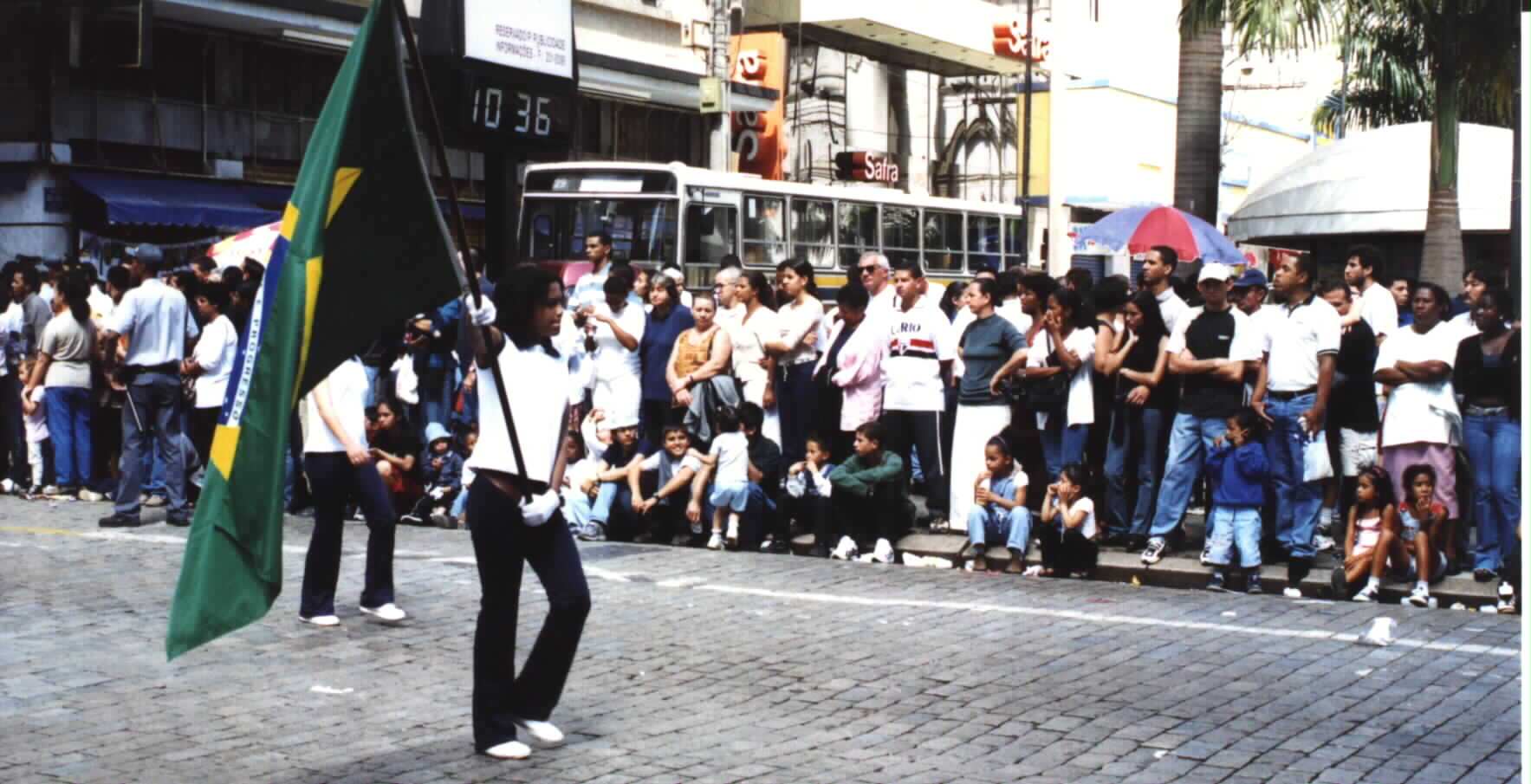
BRAZIL CELEBRATES INDEPENDENCE DAY IN CAMPINAS, SAO PAULO .
By Noe Dorestant, E.E.
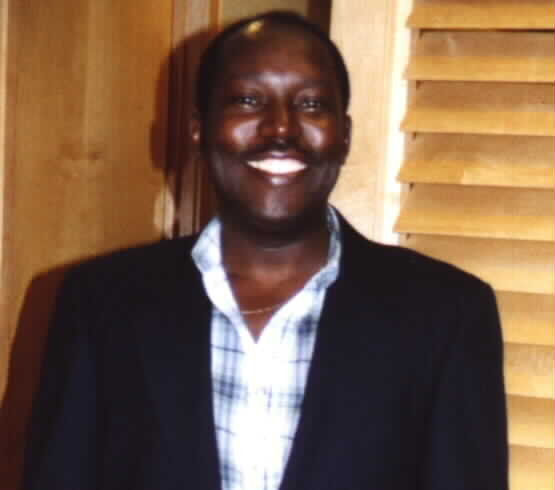
It is a sunny tropical winter day in the lovely hill city of Campinas, in the Brazilian most prosperous and industrialized state of Sao Paulo. It is also a solemn and historical Thursday morning of September 7th, 2000. The day of the anniversary of the 178th year of independence of the people and this great piece of land, which was ruled by Portugal from 1500 to 1822.

A young Brazilian woman carrying unpretentiously the flag and the symbol of the greatest democracy and currently most successful and largest country of all of South America.
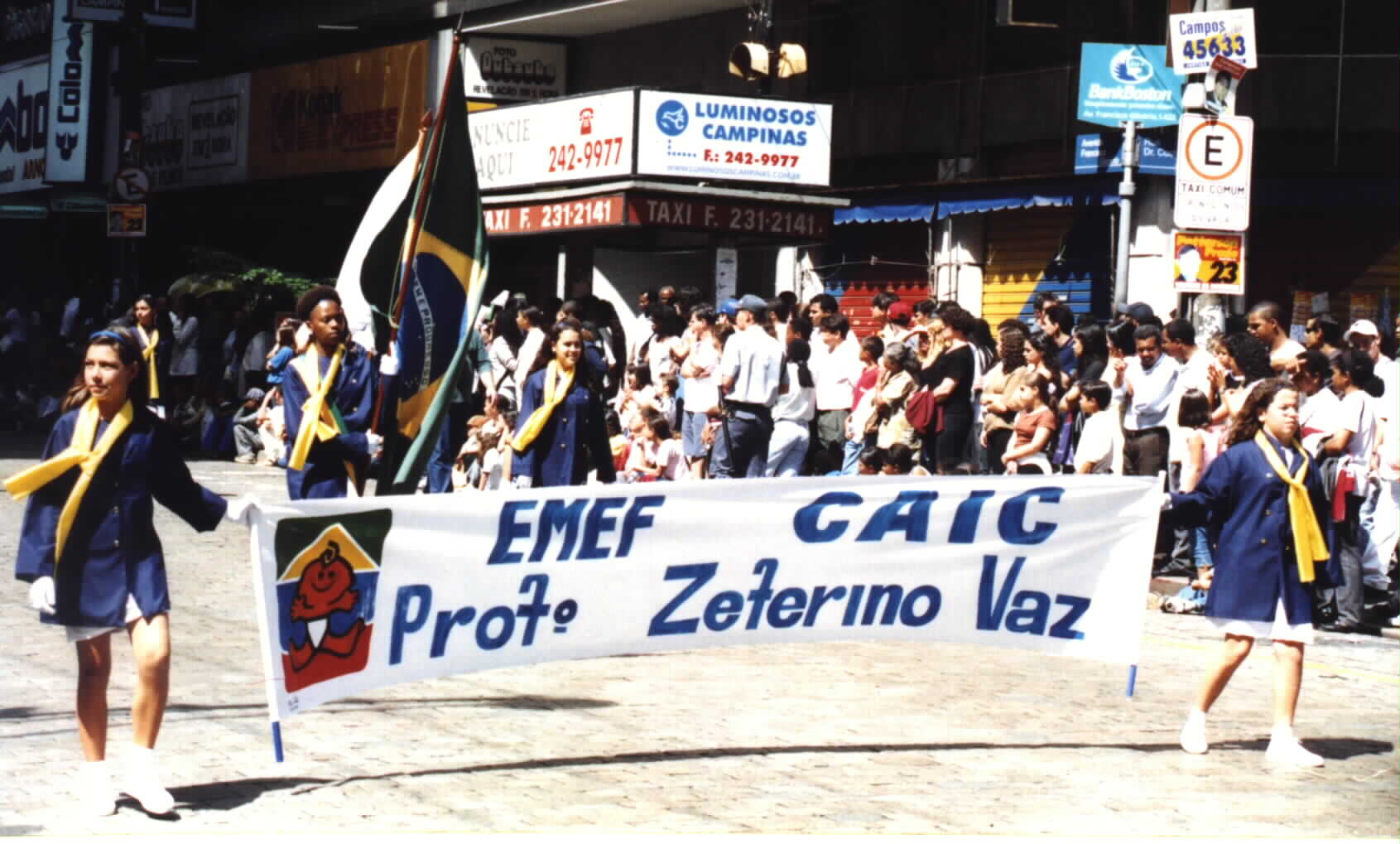
Brazilian students carrying with dignity the Brazilian flag and school banner during Independence day march celebration in the main street of Campinas.
The colorful and purposeful diversity of Brazilian people was displayed in a peaceful rainbow of a united gathering of skin colors of all Godchildren: the native American Indians (or the indigenous as they like to be called), the Portuguese, the Dutch, the Africans, the Spaniards, the French, the Japanese to name a few, not to forget yours truly, a son of Haiti who was fortunate to have chosen to be a part of this early morning celebration.

A rainbow of flags and people was obviously an integral part of the Independence day decor, with the appropriate background music of the world famous tune (It is a small world after all.)

Marching in harmony to the beat of synchronized drummers. .
Republica Federativa do Brazil although had been an independent country since 1822, it only became a republic in 1889, when Emperor Pedro II was forced to relinquish power.

Disciplined and well trained boys and girls marching together step by step and beat by beat.
Brazil first inhabitants, the American Indians have survived as tribes in the low lands of the Amazon basin, however their scattered presence and blending with their integration with the population of immigrants, accounts for the growth of this nation to a melting pot of 170 millions plus living bodies and souls, where all the bloods of the people: the Amerindians, the Africans and the Europeans have been mixed to create a spectrum of human coloring that perhaps Adam and Eve would be delighted to see today, had they not eaten from the God forbidden tree, that rendered them and their descents all poor mortals.

Brazilian girls rising up to the occasion.
Brazil is well known for its soccer, for not only having been four times champion of the world but for also having had emerged amongst its people of African descents, a legendary and world soccer icon, Pele'. Haitians are passionate and fond of Brazilian soccer style and often compete on the soccer field with Brazilian counterparts.Haiti International Champion of Brazilian Copa Sambola
 Leading Catholic church in Campinas (Estimated that 80% of Brazil population are Catholic church followers.)
Leading Catholic church in Campinas (Estimated that 80% of Brazil population are Catholic church followers.)
People take their church activity seriously, which is often coupled with civic duty. Meanwhile Soccer is by far he greatest Brazilian pass time and national sport. Soccer volleyball played bare foot on the beach, is on the rise and is often seen played by mix team of men and women. Brazilian music and their Samba dance is known and recognized as a great mood unifier, with its repetitive set of lateral steps that can keep even the oldest of us in good physical shape. Call their dance Brazilian aerobic if you wish.
What make Brazil great is not just its people, its church, and its carnival. It also has has a great landscape, which produces what most people on earth likes, you guess it: coffee. Brazil has been for a long time the world first producer of coffee, averaging 26% of the world harvest of delicious strong flavor coffee that Brazilians religiously drink after each meal. Besides coffee and cocoa, it produces a great deal of tropical fruits, such as: papayas, pineapple, watermelon, bananas, mangos, a variety of vegetables, corns, beans, sugar cane. Its sea coast and rivers harbors a large variety of tasty tropical fish, not to forget the unique to Brazil, the sweet water pink dolphin and much more.

Brazilians of all colors marching for a common goal and better living condition for all.
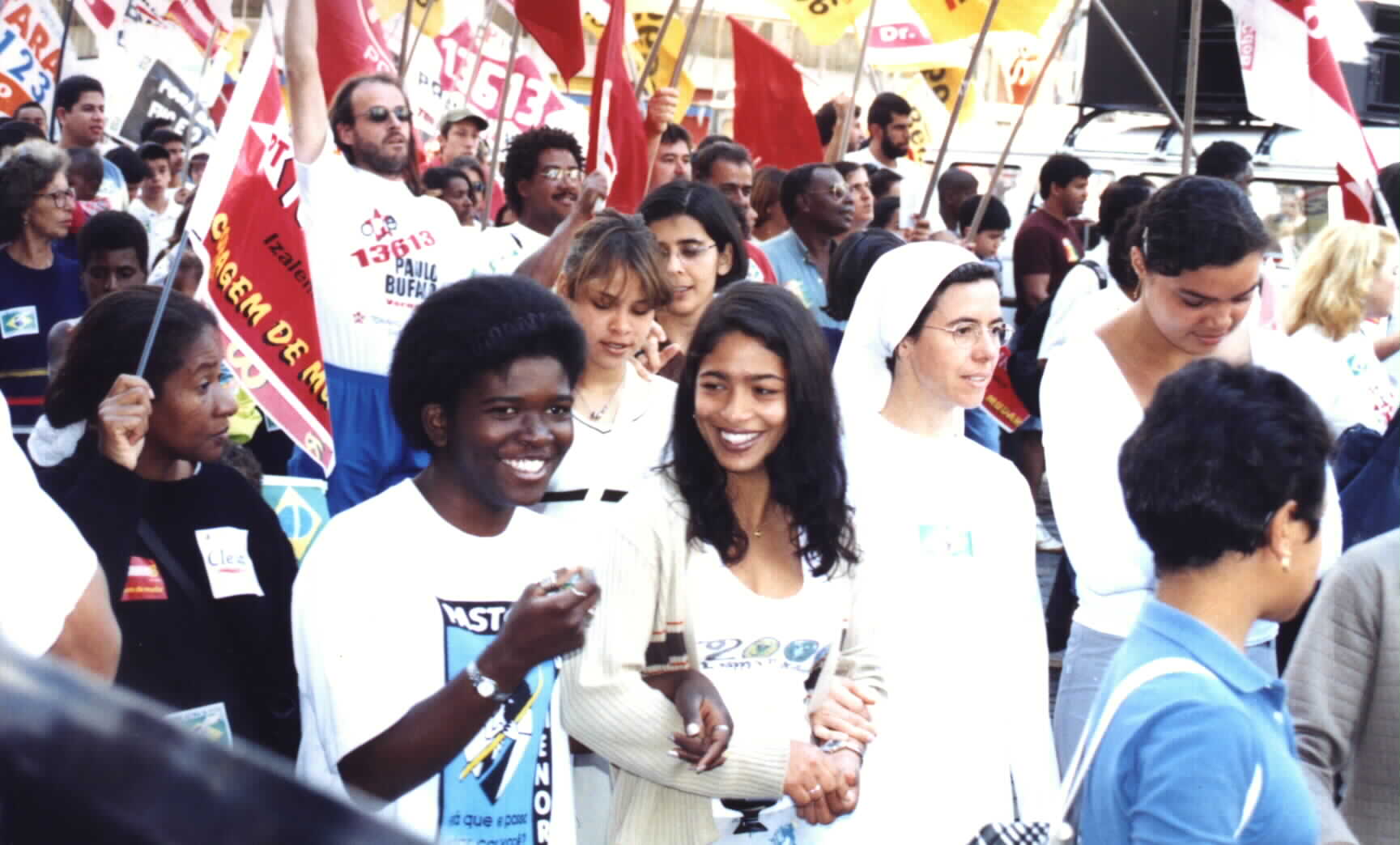
A united people of Brazil marching on with determination for a future that includes all its citizens without exception.
Brazil is also rich in minerals, it has in its ground a reserve of iron ore evaluated to one quarter of the world deposit. It is self sufficient in the generation of electricity by hydro or petroleum means. Thus with its energy problem under control, Brazil has the most vibrant industrial production of all of South America. It is estimated that the annual industrial production of the state of Sao Paulo alone is more than that of all Canada combined. How about that for a country, which during colonial time was forbidden to produce finish goods and had to export all its raw materials to the Colonial power of Europe, mainly England, which would in turn sold them back the finish goods at price they often could not afford. It was because of the inability of selling the finish goods that the British suggested the liberation of the Brazilian slaves, which would soon have buying power once they had gained the freedom to work for themselves and earn money to buy Europeans finish goods and by so doing help not only the Brazilian economy, but primarily feed the industrial revolution of Europe.

The message is loud and singing clear: (Diga nao a divida, si na vida/Say No to the International debt, say Yes to Life)
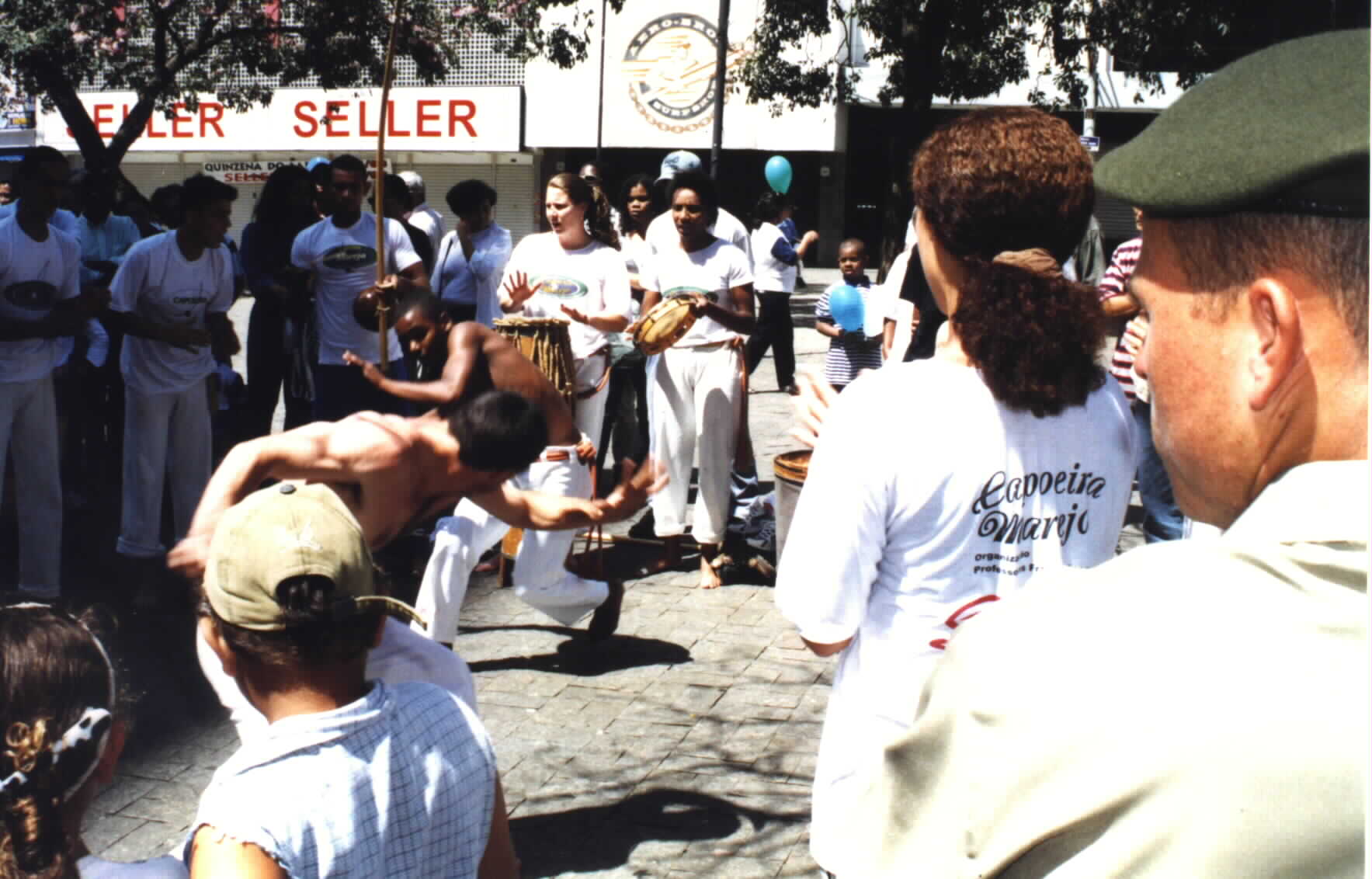
Brazilian of all shades practicing the old African/Brazilian dual combat, under the disguise of musical dance. This effective blend of dance and martial art self defense originated out of necessity during the inhuman treatment on the sugar slave plantations(where the slaves where valued at 60% of the assets on the plantation). Some of those same Africans(kidnapped or sold and brought in as slave workers from Angola, Nigeria, Benin etc..) who escaped to regain their freedom, created the Quilombos villages in the Northeastern seacoast part of the country, which they were determined to defend in order to conserve their own forged freedom and independence, and would at the same time also help protect Brazil against potential invasion by competing hostile and greedy European powers in search of rich lands with gold, diamonds, precious stones and other minerals to: explore, lute, steal, seize, conquer, exploit and settle in, with a more inhuman mentality than the few Europeans who had left Europe because of famine, plagues or persecution. For instance, the Dutch were forced out of Brazil, some of them resettled in the Caribbean, where they continued their lucrative slave trades from the tiny island St. Eustatius (An islet claimed by France until 1625, located somewhat between St. Christopher and St. Croix in the lesser Caribbean Antilles) where Dutch merchants controlled the slave and sugar trade, the Dutch used Curacao another island of the Caribbean as the headquarter of their slave trafficking. Dutch sugar planters of Brazil were also forced out to resettle to the Caribbean island of Barbados and the Northeast South American country, Dutch Guiana (Surinam), a former British colony which was ceded to the Dutch. Meanwhile the pirates, the buccaneerrs, the smugglers, the traders and the marauders were having a field days stealing gold from Spanish galleons, which were carrying to Spain the gold they had in turn taken from the land of the Mexican and Peruvian South American-Indians, as well as the land of the copper skin and the fierce fighters black skin Carib Indians (mixture of copper skin Carib Indians and black/brown (coffee/cocoa) skin West Africans. History also reports that 20% of slaves sold to the so called New World, came out of Benin(Dahomey kingdoms and former French colony until 1960, currently one the poorest country of Africa, despite rich reserve in offshore petroleum, chrome and iron ore), where one of the African king of Dahomey appointed a Brazilian, Don Francisco Felix de Souza as his slave trader. Don Francisco de Souza is today recalled by his mix descendents as the King of Ouidah, the port of no return for most of the West African slaves, who under inhuman conditions were shipped to Brazil and the Americas. Francisco who also was busy with African women, went on to father 99 sons and countless daughters. He died in Dahomey and was buried in his own mansion of Ouidah where most of his three thousands plus descendents still live today in his royal court which has been preserved as a shrine for the evil legacy of slavery by Africans and Europeans.
Brazil with an area of 8,511,965 Kilometers square is the largest country of South America. It shares common borders with no less than ten countries, namely by starting counter clockwise on its northern part: French Guyana, Surinam, Dutch Guyana, Venezuela, Colombia, Peru, Bolivia, Paraguay, Argentina and Uruguay on its most southern part. Needless to say that with all these neighbors that Brazil had to have a good foreign policy to survive without external conflict. The Brazilian seems to have been very wise in adapting the good neighbor policy and as a giant nation, have chosen not to use (La raison du plus fort est toujours la meilleure.) its power to take advantage of its smaller neighbors. But rather has remained a beacon for peace and democratic prosperity for all to envy and emulate.
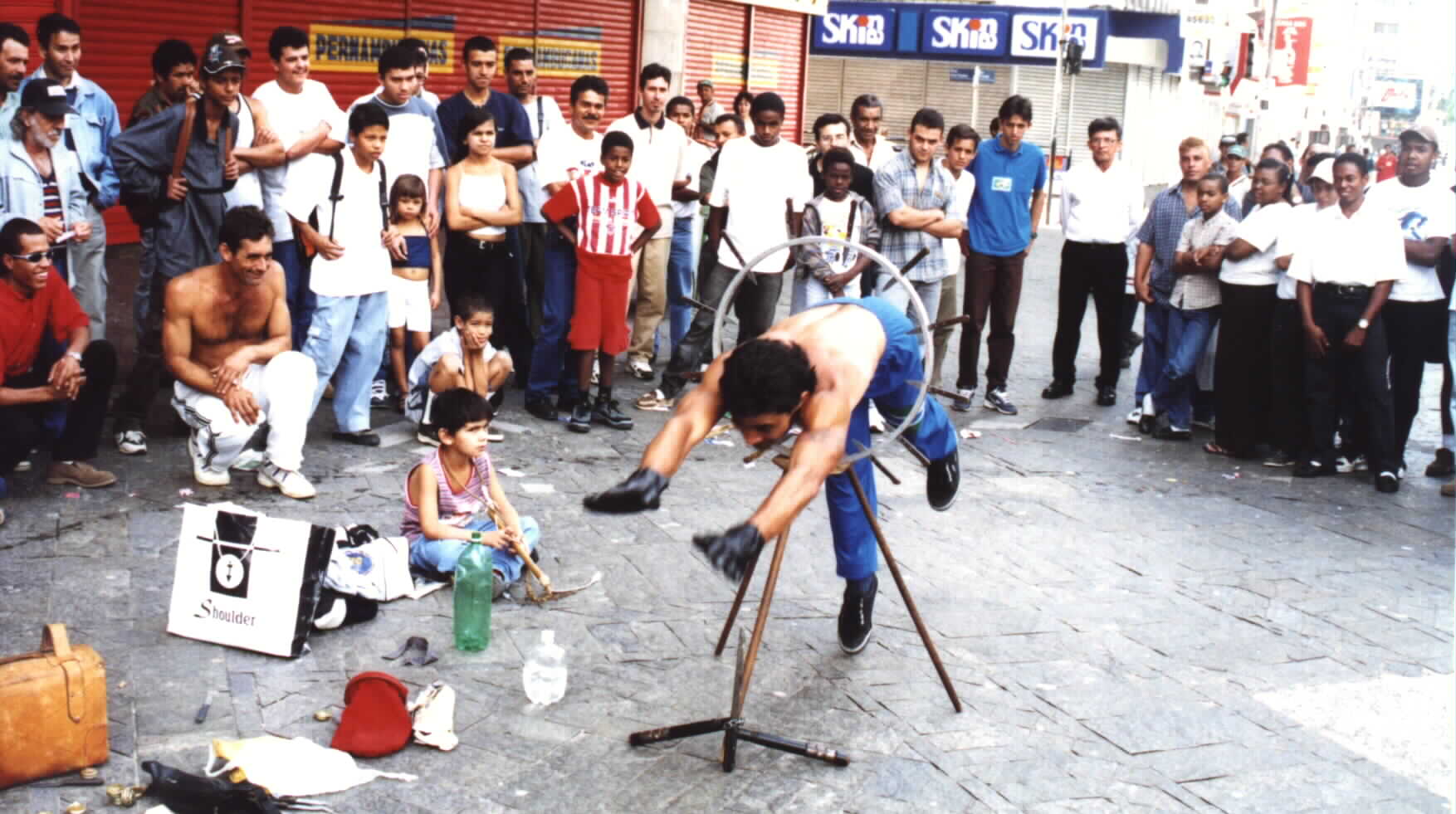
A Brazilian Indian (indigenous people) dedicated to Haiti his last acrobatic daring display of flying through a ring of 12 knives without a scratch.
I must admit, that I was inspired to write this page of Brazilian history by this American Indian Indigenous Brazilian Martial Art expert, who encouraged me to stay around just a little longer, upon observing that I was about leave after a long stay watching him talk with no action to fulfill his promise of some exciting acrobatic moves . After reassuring himself that I was from Haiti, he alerted his captivated audience: that he would dedicate the last jump of its show on Brazilian Independence day to the people of Haiti. This made me an instant celebrity and now all eyes were on me and the word Haiti, Haiti... became a rallying cry and a warm up for the crowd, he had hypnotized with long talks and delay tactics. It felt truly honored when he told me in Portuguese: I want you to be here in front of me inside the circle of Brazilian people, so that you may take the best possible picture of what I am about to perform in honor of your country, Haiti. Truly a historical moment captured on film. As you can see, he flew through the ring of 12 knives shirtless, with only a pair of probably steel gloves to protect his hands, in case he would have made a bad landing on the biggest and most dangerous 13th knife set up on the ground bayonet's like. I am happy to report that he had a magnificent and safe landing, without a single scratch on any part of his body. To me that was an eloquent display of the courage of the Brazilian people and their determination to advance and succeed despite the hazard and obstacles on the way. May it be imposed or self imposed. A though act for Haiti or any Haitian to follow or emulate without practice, proper discipline, or physical and mental conditioning. Where there is a will, there is always a way, says the proverb. The Brazilian have surely found the way to do many things right on their independence day. I must admit, that I was truly impressed and I enjoyed every minute of the celebration and the memories of Independence Day of the Republic of Brazil in the city of Campinas.
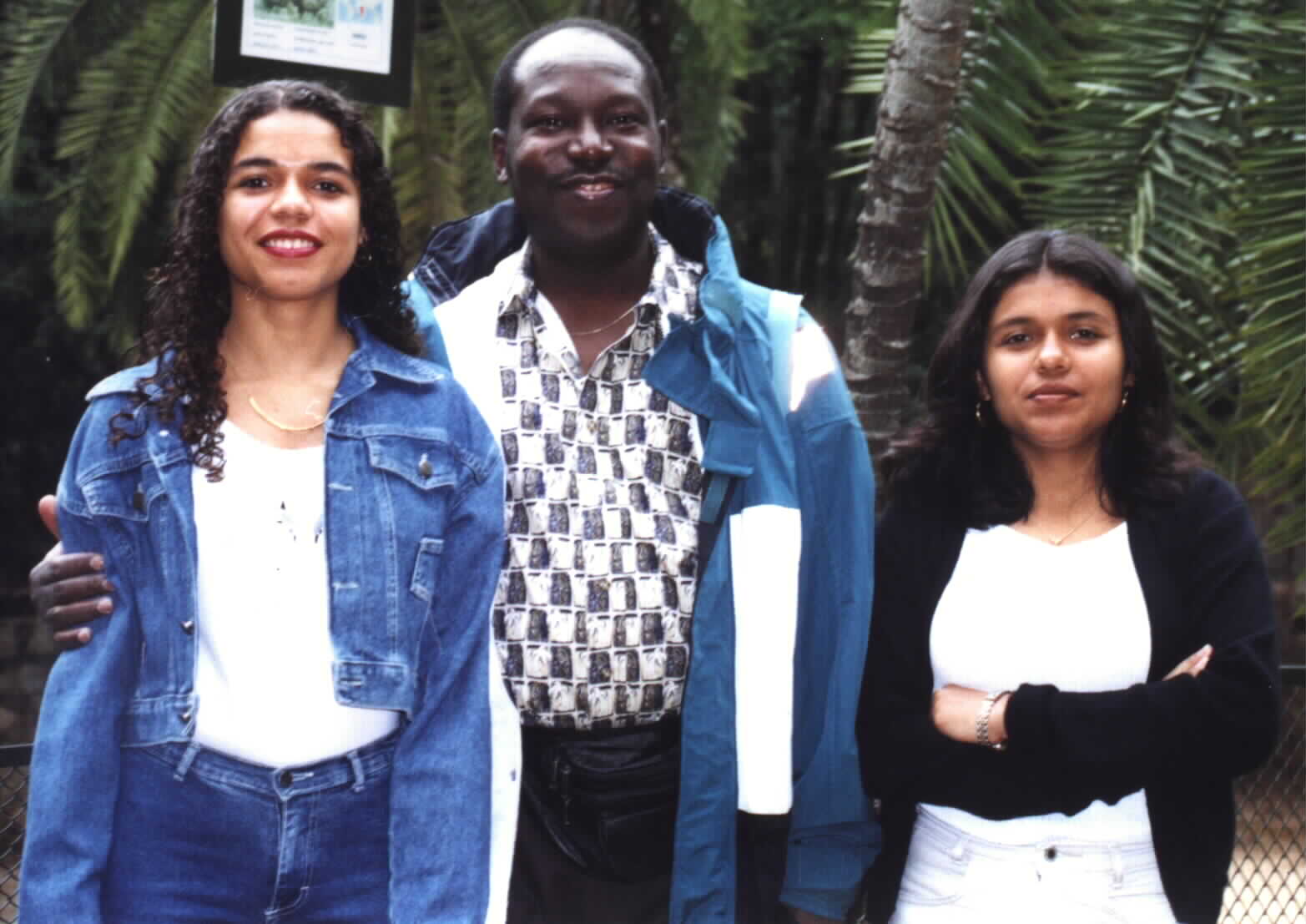
A Haitian national, Noe Dorestant wishing Happy Independence day to the resourceful, creative, industrious, lovely and hospitable people of Brazil.
Note: All pictures were provided by Noe Dorestant as a token of his civic contribution to help promote Haitians and the community in which they reside. If you copy and plan to reuse any of these picture. PS give credit to the originator. All rights reserved 2000. Web page written and designed by Noe Dorestant on 10/10/2000.